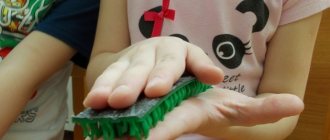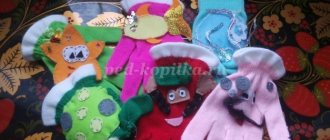Progress of the game.
Children are invited to go on a trip around the world. They must figure out where their path will lie - through the desert, along a mountain path, through a swamp, through a forest, a jungle, across the ocean on a ship - and change their behavior accordingly.
№ 7 “Mishka came from a walk”
Goal: to develop object-based game actions; form
accompanying speech.
Equipment: teddy bear, sled, crib, high chair, set of clothes for
bear cub (pants, felt boots, coat, hat)
.
Card index of theatrical games in the younger group
Card index
in the younger group
Explanatory note
Theatrical play is an effective means of social-personal, cognitive-speech and artistic-aesthetic development of a preschooler. The development of theatrical play in preschoolers is more effective with a special organization of the pedagogical process.
This becomes possible if the teacher gradually reorients the child from the process of the game to its result. The path to development of play is joint play between an adult and a child, the creation of an enriched play environment that encourages independent play creativity in free interaction with toys and peers. Play as part of the educational field “Socialization” is integrated with all educational fields, since it is the main form of implementation of various types of children's activities, including organized educational activities, a method of educating and developing younger preschoolers, and a form of organizing the lives of children in kindergarten.
«The turnip grew big and big"
Russian folktale
Tasks:
Read a fairy tale to the children.
To teach listening to a story using a visual image Staged fairy tales on flannelgraph
Game-situation “In our yard” To evoke positive emotions in children;
Enrich the experience; awaken interest in the game, the desire to imitate the intonation of an adult’s voice.
The BI-BA-BO puppet theater and flannelgraph are used
A.
Barto “Toys”
Tasks:
Introduce poems.
Teach children to perform characteristic actions when reading again, repeating lines of text after the teacher
To develop the ability to convey basic emotions through facial expressions, gestures, and movements.
Encourage children's willingness to participate.
Used tabletop theater toys
Fairy tale "Kolobok"
»
Tasks:
Arouse interest in theatrical play through the first experience of communicating with characters.
Invite children to follow the development of the plot based on illustrations,
Develop attention and visual - effective thinking;
Learn to name characters and their actions. Reinforce in speech the names of animals and their characteristics; expand the active vocabulary: round, ruddy, red and cunning, clubfoot, etc.
Theatrical game based on a fairy tale (the theater on spoons, Bi-Ba-Bo is used;)
Nursery rhyme “Cucumber, cucumber...”
Cucumber, cucumber,
Don't go to that end
There's a mouse living there
He'll bite your tail off!
Tasks:
Teach children to pronounce a nursery rhyme. Mastering affectionate behavior (cucumber, ponytail, mouse).
Develop attention, enrich vocabulary.
Cultivate careful behavior.
Option 2. Use in a game (the mouse lives there - the children run away
Theatrical nursery rhyme game (head masks are used)
Folk game: “The gray bunny is sitting”
Tasks:
Improve the ability to examine objects, learn to examine, feel;
Learn to perform movements as shown by the teacher and pronounce the words of the song
Develop emotional responsiveness, the desire to communicate with peers, play together;
Game - the situation “The girl forgot to feed the kitten, he couldn’t remember how to ask for food.”
Tasks:
Learn to identify yourself with a theatrical character; develop mindfulness;
Learn to combine movements and speech; consolidate knowledge about the environment.
The game is the situation “For the grandfather, for the woman, the Ryaba Hen laid a golden egg.”
Tasks
Stimulate children's emotional perception of theatrical play and active participation in it;
Develop children's physical activity. Retelling a fairy tale with movements.
Strengthen the ability to imitate movements
Theatrical play based on a fairy tale, all types of theater are used
“ We won’t tell you where we were, but we’ll show you what we did.”
Tasks:
Encourage children's attempts to participate in a collective conversation and make joint decisions; develop creative imagination; encourage children to improvise.
Using a counting rhyme, the driver is selected. He leaves the room. Children agree on what and how they will portray. The driver returns and asks: “Where have you been, boys and girls? What did you do?" The children answer: “We won’t tell you where we were, but we’ll show you what we did.”
Children show the actions they came up with.
During the game, the teacher first advises what and how to depict. When the children get used to it, he only suggests what to depict, and how to do it, they decide for themselves
TV oral tasks for the development of pantomime.
Tasks.
1. Show how the Goat (Baba Yaga, Little Red Riding Hood, etc.):
- looks in the mirror;
- tries his favorite dish
- tries his least favorite dish
- Dialogues - pantomimes:
- conversation between two “foreigners” who do not know each other’s language, using gestures in various situations, for example: in a store, at a train station in a pharmacy, etc.;
- act out a situation in which one fairy-tale character steps on another’s foot (for example, on a tram); show how they sort things out using gestures.
3. Riddles - pantomimes:
- in a store (toy store, grocery store, grocery store, furniture store, etc.): guess what product the buyer needs or what product is on the shelf;
- at the zoo: guess who is sitting in the cage;
- guess the profession (based on characteristic movements and posture);
- guess how the journey took place (by boat, plane, train, etc.);
- guess what the weather is like outside;
- identify a passerby by their gait (ballerina, soldier, very old person, fashion model, person whose shoes are pinching, etc.).
4.Show (with hands or fingers):
- Stay where you are!
- Come with me!
- Goodbye!
- Let's make it up.
- I love you!
- I'm afraid.
Fairy tale "Kids and the Wolf"
Tasks:
Introduce children to the work, teach them to follow the development of the plot based on illustrations. During special moments
Game "Bunnies for a walk"
Tasks:
Teach children to perform playful actions and engage in play with peers.
To develop the ability to perform basic role-playing actions. Game situation using various attributes (table theater, circle theater, etc.)
Tasks (children hold “bi-ba-bo” dolls or ordinary toys in their hands
).
1. The dolls meet each other and:
a) say hello
b) ask each other about health,
c) say goodbye.
2. One doll accidentally pushed the other. We must ask for forgiveness and, accordingly, apologize.
3. The doll is celebrating her birthday. Her friends come to her and:
a) congratulate you on your birthday and give gifts.
b) the doll thanks for the congratulations and invites you to the table.
c) one of the guests was late: ask for forgiveness for being late.
d) one of the guests accidentally spilled compote on the tablecloth, play out the actions of the hosts and the offender.
3. Some tasks can be offered to children to complete without dolls:
a) knock, go into the group and call one of the children with a gesture (silently, so as not to interrupt the teacher’s story);
b) go to the head (methodologist, speech therapist, etc.) and give her a message;
c) explain to “mom” why clothes are dirty after visiting kindergarten;
d) apologize to the children for the fact that the ball rolled and broke the sand buildings.
Note: the content of communication sketches can include exercises on etiquette and culture of behavior.
Progress of the game.
The object is placed on a chair in the center of the circle or passed around the circle from one child to another. Everyone must act with the object in their own way, justifying its new purpose, so that the essence of the transformation is clear. Options for the transformation of different objects:
a) pencil or stick - key, screwdriver, fork, spoon, syringe, thermometer,
toothbrush, paint brush, pipe, comb, etc.;
b) small ball - apple, shell, snowball, potato , stone, hedgehog,
bun, chicken, etc.;
c) notebook - mirror, flashlight, soap, chocolate, shoe brush, game.
You can transform a chair or a wooden cube, then children must justify the conventional name of the object. For example, a large wooden cube can be turned into a royal throne, flowerbed, monument, bonfire, etc.
8. Grandma Malanya
Target. Develop attention, imagination, resourcefulness, ability to create
images using facial expressions, gestures, plasticity.
Progress of the game.
With the help of a rhyme, a child is selected who invites the children to the “birthday”
. Guests come one by one and bring imaginary gifts.
With the help of expressive movements and conventional play actions, children
must show what exactly they decided to give.
No. 5 “King”
(version of the folk game)
Goal. Develop actions with imaginary objects, the ability to act
agreed upon.
Progress of the game.
Using a rhyme, a child is selected to play the role of king. The remaining child workers are divided into several groups (3 — 4)
and agree on what they will do and what work they will be hired for. Then they approach the king in groups.
Workers. Hello King!
King. Hello!
Workers. Do you need workers?
King. What can you do?
Workers. Guess it!
Children, acting with imaginary objects, demonstrate various professions: cooking, washing clothes, sewing clothes, embroidering, watering plants, etc. The king must guess the profession of the workers.
If he does it correctly, he will catch up with the fleeing children . First
the caught child becomes king. Over time, the game can be complicated by introducing new characters (queen, minister, princess, etc.), as well as inventing the characters of the characters (king - greedy, cheerful, evil; queen - kind, grumpy, frivolous).
№ 6 "Trip around the world"
Target. Develop the ability to justify your behavior, develop faith and
imagination, expand children's .
Progress of the game:
Using a counting rhyme, the driver is selected. He leaves the room. The children agree on what and how they will portray. The driver returns and asks:
“Where have you been, boys and girls? What did you do?"
The children answer: “We won’t tell you where we were, but we’ll show you what we did.”
.
Children show the actions they came up with.
During the game, the teacher first advises what and how to depict.
When the children get used to it, he only suggests what to depict, and they decide for themselves how to do it.
6. Trip around the world
Target. Develop the ability to justify one’s behavior, develop faith and imagination, and expand children’s .
Progress of the game:
Teacher in front of the children sitting at the table. There is a house on the table, from the window
which a bear cub is peeking out.
Teacher. Oh, whose face appeared in the window?
The children answer that it is a bear. The teacher takes him out from behind the house and draws the children’s attention to how the bear purrs when greeting them. Then he asks the children to purr in the same way .
Suddenly the bear hides behind the house.
Teacher: Teddy bear, playful Teddy bear!
Where are you? Where are you? Answer me!
Teddy bear, Naughty Teddy Bear!
Where are you? Where are you? Show yourself!
The bear's head appears in the window again. He shakes his head and purrs. Children imitate him. The display game is repeated at the request of the children . Various characters familiar to children can hide. And every time the teacher encourages the children to imitate the “voices”
these characters.
№ 3 "Finger Game"
Goal: to introduce children to theatrical activities ; teach them to combine
words with movements.
Equipment: finger theater .


